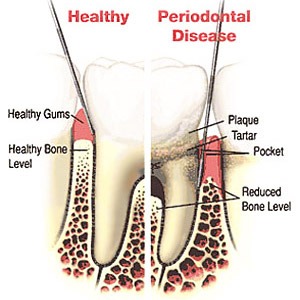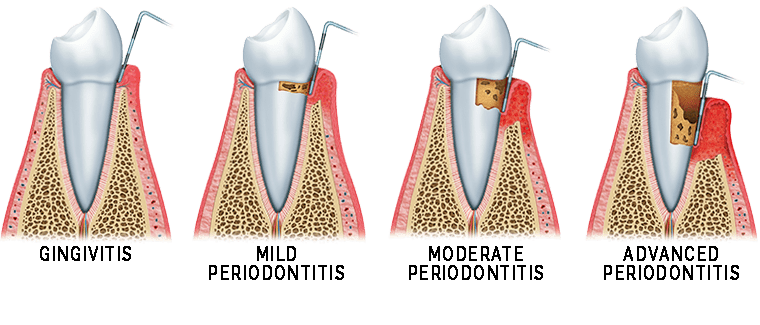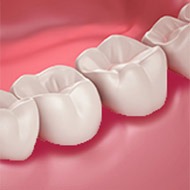About Gum Disease

- How Gum Disease Progresses
- Levels of Gum Disease
- Gum Disease Symptoms
- Contributing Causes of Gum Disease
- Gum Disease Link to Other Health Problems
- Come see us for a Full Exam and Consultation
What is Gum Disease?
 Gum disease is also known as periodontal disease, from Greek peri “around” and odont “tooth.” It is characterized by a continuous and progressive bacterial infection and inflammation in the gums and bone surrounding your teeth. If left untreated, it can cause the gums to detach from the teeth and the surrounding gum and bone tissue to be eaten away. Teeth can become loose and can eventually be lost.
Gum disease is also known as periodontal disease, from Greek peri “around” and odont “tooth.” It is characterized by a continuous and progressive bacterial infection and inflammation in the gums and bone surrounding your teeth. If left untreated, it can cause the gums to detach from the teeth and the surrounding gum and bone tissue to be eaten away. Teeth can become loose and can eventually be lost.
Gum disease is the leading cause of adult tooth loss in the United States. It is a “quiet” disease that often produces no pain or discomfort until it has reached an advanced stage. Gum disease has been linked to other serious health problems such as cardiovascular disease, diabetes, osteoporosis and certain types of cancer. It is important to detect it and treat it as early as possible, for the best outcome to gums and teeth.
Expert Periodontal Disease (Gum Disease) Treatment
As periodontists, we are highly trained specialists in the prevention, diagnosis and effective treatment of gum disease. The doctors can eliminate the bacterial deposits on gums that are eating away your gum and bone tissue and restore your oral health. In many cases we can even reverse the damage to gums done by gum disease through effective treatments to rebuild lost gum and bone tissue.
How Gum Disease Progresses
When your gums and jawbone are healthy, they are connected firmly to your teeth through connective tissue known as a periodontal ligament, and your teeth remain stable in their positions. Healthy gums are firm, pink and do not bleed easily. The gums naturally attach to your teeth just below the visible gum line.
Bacteria from food and other sources can get onto your teeth and below your gum line. If these are not regularly cleaned away by brushing and flossing, they form a sticky biofilm on your teeth known as plaque. As the plaque builds up, large deposits of plaque start to harden into tartar, or calculus.
The bacterial plaque and calculus give off toxins that eat away your tooth enamel and gum tissue and cause your gums to become inflamed. This causes the gums to detach from your teeth, allowing more and more bacteria to accumulate and plaque and calculus to move progressively farther below the gum line. Your gum tissue itself will become infected and the supporting bone around the affected teeth is eventually eaten away as well. This progression to gums may continue until teeth become loose or even fall out.
Levels of Periodontal Disease
There are several levels of gum disease progressing in severity from mild to advanced.

Gingivitis
The mildest level of gum disease is known as gingivitis and consists of a mild bacterial infection and inflammation of the gums only. There is no gum detachment at this point and no loss of the supporting bone. With gingivitis there is some redness and non-painful swelling of the gums, and the gums may bleed when brushing. This level of infection can usually be eliminated by thorough professional cleaning combined with effective home oral care.
Periodontitis
The second level of gum disease is more severe and is called periodontitis. Here the infection has grown to where it causes the gums to progressively detach from the teeth, forming ever deeper pockets of space between the teeth and gums. It also causes the ligament and bone that support your teeth to be continually eaten away.
As the gum pockets deepen, more aggressive strains of bacteria are able to populate them, and the infection becomes more destructive the deeper the pockets become. This causes the bone loss and deterioration of gum tissue to accelerate in speed and intensity as the infection reaches an advanced stage.
Stages of Periodontitis
Periodontitis progresses in severity from mild to moderate to advanced. Your level of gum disease will be determined by gently measuring the depths of your gum pockets with a small probe. You will be evaluated for loose teeth, gum recession, and the level of bone loss around your teeth by examining your X-ray images.
Mild periodontitis
Gum pocket depth is between 4mm and 5 mm and bone loss has started to occur around your teeth. There is often bleeding when the pocket is probed or when you are brushing your teeth. The tissue around the gums is tender and there may occasionally be some pus emerging from it.
Moderate periodontitis
Gum pocket depth is between 5mm and 6mm, and, in addition to the above symptoms, the bone loss is more extensive. Many patients also have a bad taste in the mouth and/or bad breath at this point.
Advanced periodontitis
Gum pocket depth is 7 mm or greater and the bone loss is severe in this stage. There is more frequent pain and bleeding in the gums, and abscesses on gums will tend to flare up and go away. There can be gum recession and the teeth will often be loose or will have drifted out of their normal position. Tooth roots are only 10 – 12 mm long, so when the pockets between your teeth and gums are 7mm or greater, your teeth are in severe danger of being lost.
Gum Disease Symptoms
If you notice any of the following symptoms, you should come see our doctors right away for a comprehensive periodontal examination. Your doctor will tell you if you have gum disease, how far it has advanced and what gum disease treatment options are available to effectively eliminate it.

- Sensitive teeth
- Red or swollen gums
- Gums that are tender or bleeding
- Receding gums or teeth that appear longer than normal
- Chronic bad breath or a bad taste in your mouth that will not go away
- Painful chewing
- An abscess below the gum line
- Teeth that are loose or have shifted position
Contributing Causes of Gum Disease
Although the bacterial infection and its effects are the most immediately visible causes of gum disease, there are numerous contributing factors that cause the infection to take hold much easier and advance at greater speed:
- Poor home oral care – Infrequent or improper brushing and flossing fails to remove adequate bacteria, allowing the remaining bacteria to accumulate below the gum line and cause gum detachment and progressive bone loss.
- Inadequate frequency of dental cleanings – Even the best home oral care can miss some of the deeply buried bacteria, and regular dental cleanings are needed to keep prevent infection from occurring.
- Mistakes in earlier dental treatment – Poorly fitting crowns and bridges can leave spaces where bacteria can accumulate and cause infection.
- Poor diet – Lack of proper nutrition can cause chronic health deficiencies which make you more susceptible to gum disease.
- Smoking – Smoking and tobacco products restrict blood flow to the gums and reduce the tissues’ ability to resist infection or heal. Studies have also revealed that the strains of bacteria that most aggressively damage gum tissue are found in smokers’ mouths.
- Systemic health problems – Diabetes, cardiovascular disease, respiratory disease and various autoimmune disorders can contribute to gum disease by making your body less resistant to infection.
- Treatments for other health issues – Certain treatments for diseases weaken the gums or cause excess gum tissue growth which makes your mouth harder to clean. Certain medications reduce the flow of saliva. While saliva has a protective effect in the mouth, inadequate saliva makes the gums more susceptible to gum disease.
- Hormonal changes – Hormonal changes can cause the gums to become more sensitive and less resistant to gum disease.
- Genetic predisposition – An estimated 50% of the population is predisposed to gum disease, but proper home oral care and regular dental cleanings can keep the disease in check or prevent it from taking hold.
Gum Disease Link to Other Health Problems
Gum disease is a bacterial infection that causes chronic inflammation and destroys tissue. These bacteria can enter the bloodstream and cause complications in other parts of the body, and the inflammation itself can spread and cause damaging effects away from its point of origin.
Numerous studies are showing significant links between gum disease and serious health conditions such as cardiovascular disease, respiratory disease, diabetes and strokes.
Come See Us for a Full Periodontal Exam and Gum Disease Consultation
 If you think you may have gum disease or are concerned that past gum disease treatment has not been effective, come see one of our doctors for a comprehensive examination and consultation.
If you think you may have gum disease or are concerned that past gum disease treatment has not been effective, come see one of our doctors for a comprehensive examination and consultation.
The doctors will examine you to determine the extent of any gum disease present and let you know their findings so you are fully informed. Your treatment options will be reviewed in detail and all your questions will be answered.
Call to request an appointment: Sarasota/
